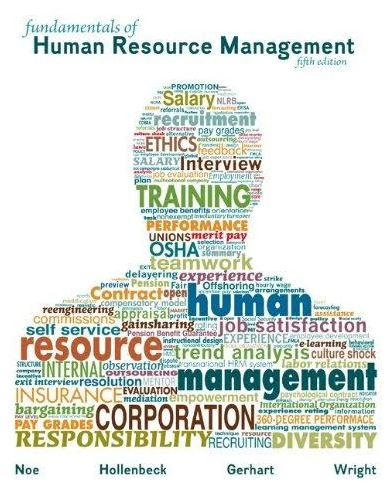
Fundamentals of Human Resource Management 5th Edition by Raymond Noe, John Hollenbeck, Barry Gerhart, Patrick Wright
Edition 5ISBN: 9780077515522
Fundamentals of Human Resource Management 5th Edition by Raymond Noe, John Hollenbeck, Barry Gerhart, Patrick Wright
Edition 5ISBN: 9780077515522 Exercise 21
CAN EMPLOYERS TEACH ETHICS?
Engineering professor Michael Garrett recalls being a new employee at URS Corporation, an engineering and design firm headquartered in San Francisco. On his first day, he was shown around the office on a tour that highlighted safety features such as fire extinguishers, first-aid kits, and emergency escape routes. He also was instructed to complete a safety training course before he began working. During his time on the job, he received monthly newsletters with articles describing safe practices at work and at home. Reflecting on that experience, Garrett asserts that, just as a company can build a culture of safety as URS did, it can also build a culture of ethics with frequent messages affirming the company's commitment to ethical practices. In his view, making an organization ethical is not a matter of onetime training, but of continual learning, practice, and reinforcement.
Ethical behavior at work is most likely to result from a desire to be ethical combined with skills for ethical reasoning and an organizational context that encourages ethical behavior. Advocates for ethics training suggest that a training program could address all of these. For example, employees can learn the benefits of an ethical workplace. They can learn principles for arriving at ethical choices. And leaders can learn skills for creating an ethical climate by communicating honestly and treating employees with respect. These lessons will be most effective if they are tailored to the specifics of the company and if the messages about ethics are delivered by respected people from within the organization. Also, because the choice to behave ethically is a personal choice, the lessons are most powerful coming from sincere individuals, delivered face-to-face.
Continuing the same example, what steps can you take to encourage transfer of training?
Engineering professor Michael Garrett recalls being a new employee at URS Corporation, an engineering and design firm headquartered in San Francisco. On his first day, he was shown around the office on a tour that highlighted safety features such as fire extinguishers, first-aid kits, and emergency escape routes. He also was instructed to complete a safety training course before he began working. During his time on the job, he received monthly newsletters with articles describing safe practices at work and at home. Reflecting on that experience, Garrett asserts that, just as a company can build a culture of safety as URS did, it can also build a culture of ethics with frequent messages affirming the company's commitment to ethical practices. In his view, making an organization ethical is not a matter of onetime training, but of continual learning, practice, and reinforcement.
Ethical behavior at work is most likely to result from a desire to be ethical combined with skills for ethical reasoning and an organizational context that encourages ethical behavior. Advocates for ethics training suggest that a training program could address all of these. For example, employees can learn the benefits of an ethical workplace. They can learn principles for arriving at ethical choices. And leaders can learn skills for creating an ethical climate by communicating honestly and treating employees with respect. These lessons will be most effective if they are tailored to the specifics of the company and if the messages about ethics are delivered by respected people from within the organization. Also, because the choice to behave ethically is a personal choice, the lessons are most powerful coming from sincere individuals, delivered face-to-face.
Continuing the same example, what steps can you take to encourage transfer of training?
Explanation
The transfer of training to the employee...
Fundamentals of Human Resource Management 5th Edition by Raymond Noe, John Hollenbeck, Barry Gerhart, Patrick Wright
Why don’t you like this exercise?
Other Minimum 8 character and maximum 255 character
Character 255


